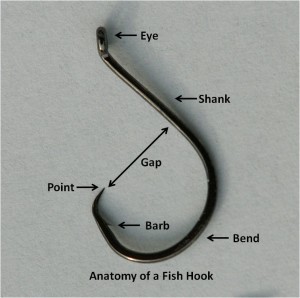Choosing the Right Fishing Hook
 Whether you are an amateur angler or a professional deep sea fisherman, the type and quality of the fishing hook you use can mean the difference between fishing success and failure. With so many different sorts of hooks on the market, making the decision what sort of hook to use can be overwhelming. These tips will help you make an informed choice before casting your line.
Whether you are an amateur angler or a professional deep sea fisherman, the type and quality of the fishing hook you use can mean the difference between fishing success and failure. With so many different sorts of hooks on the market, making the decision what sort of hook to use can be overwhelming. These tips will help you make an informed choice before casting your line.
This image, courtesy of wikipedia, shows the different parts of a standard fishing hook. Barbs should be avoided for catch-and-release fishing (common practice for trout fly fishing).
1. Evaluate the physical characteristics of the fish. Bigger fish call for a larger, harder hook.
2. Choose the right size hook for the bait you will be using. The hook should be large enough to hold the bait and hook the fish. Shorter shank hooks, for example, are not as easily detectable from the fish as longer shank hooks when using live bait.
3. Determine the size of your fishing line. A heavy gauge line can easily force a heavy hook to penetrate the jaw. A small wire hook will be bent straight without even piercing the fish if used with heavy line.
4. Decide whether any fish caught will be released. Barbless hooks and circle hooks are often the choice to aid the release of fish. Kahle hooks, however, are more deadly and are not appropriate for catch and release fishing.
Warnings: If a hook has been swallowed deeply by a fish, do not try to remove the hook. Cut the line as close to the hook as possible and release the fish. The hook is believed to gradually wear away in the water.